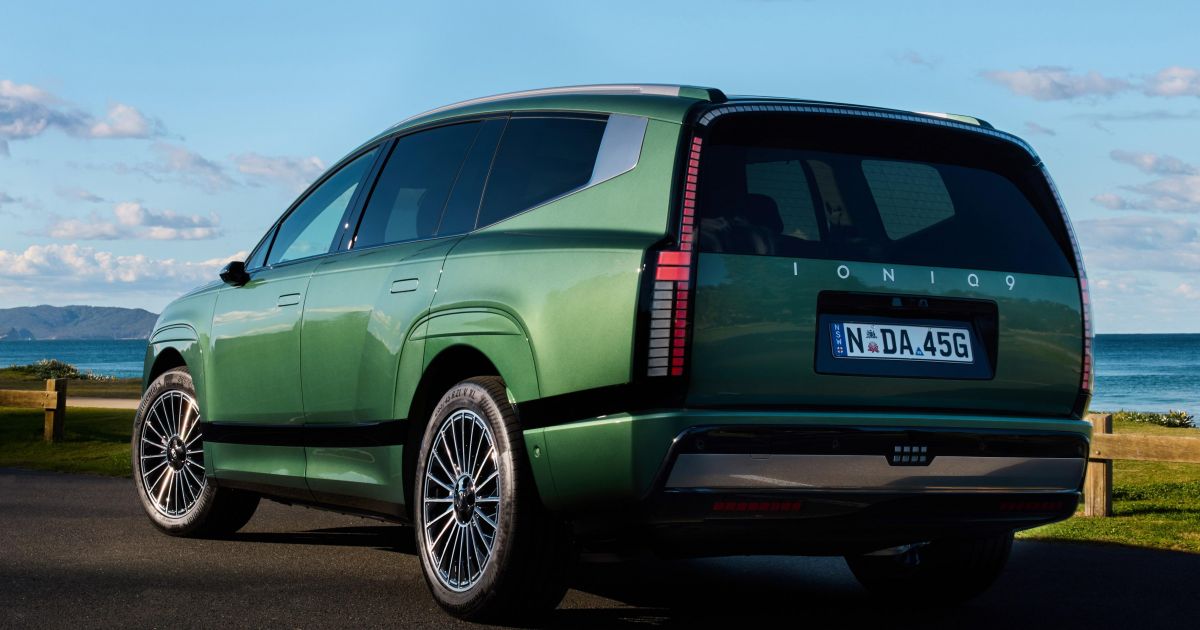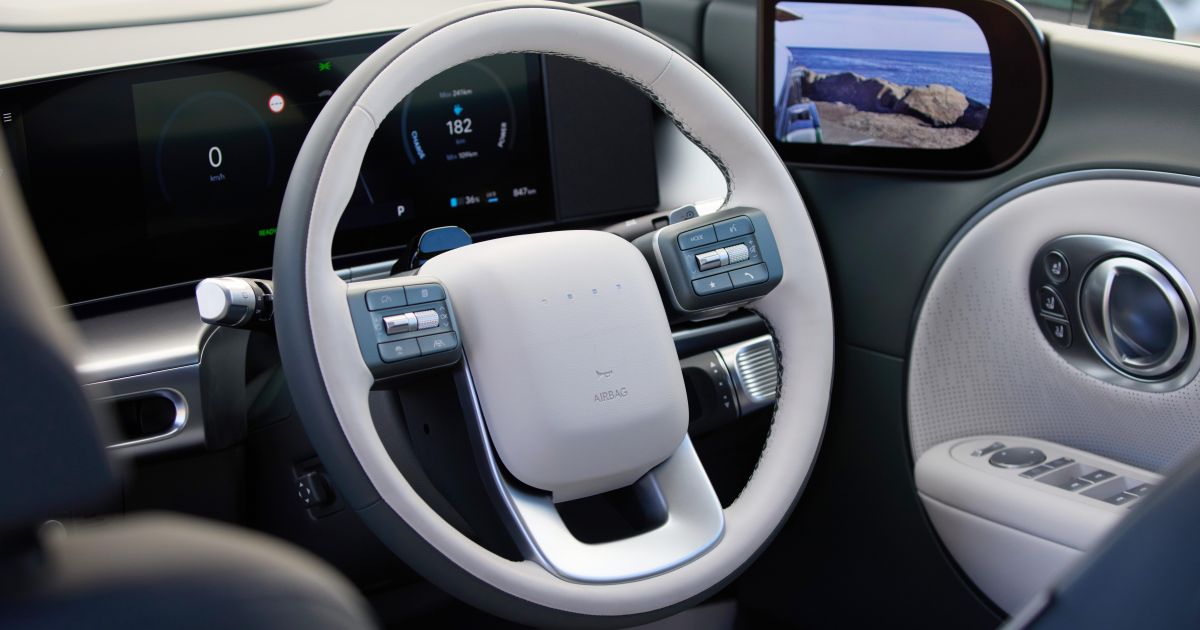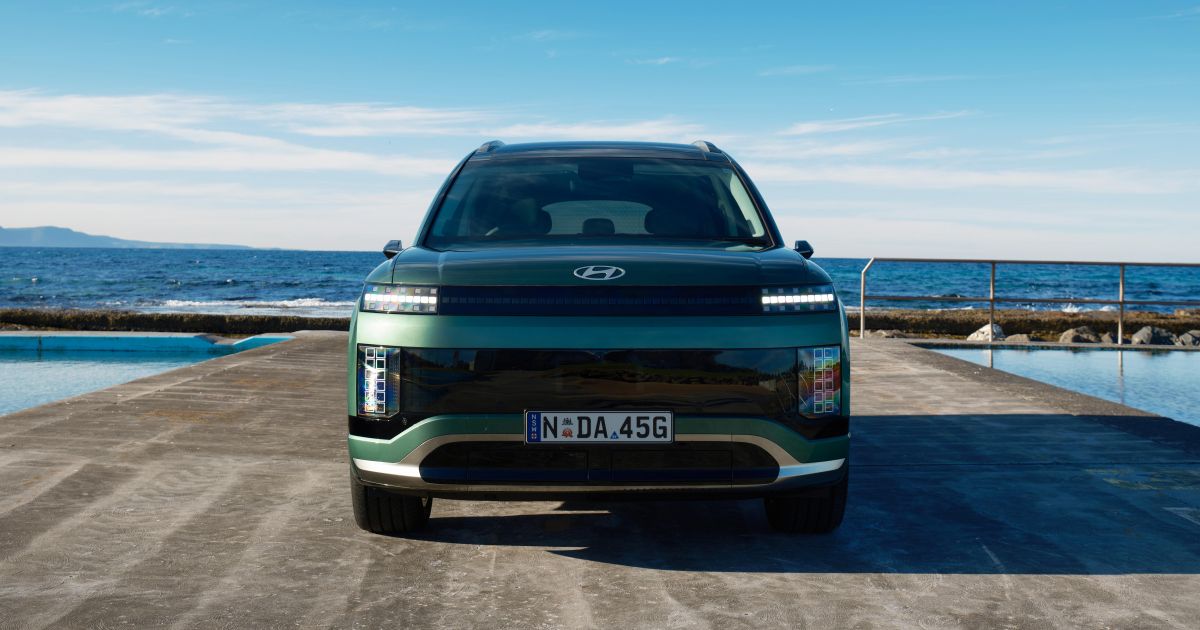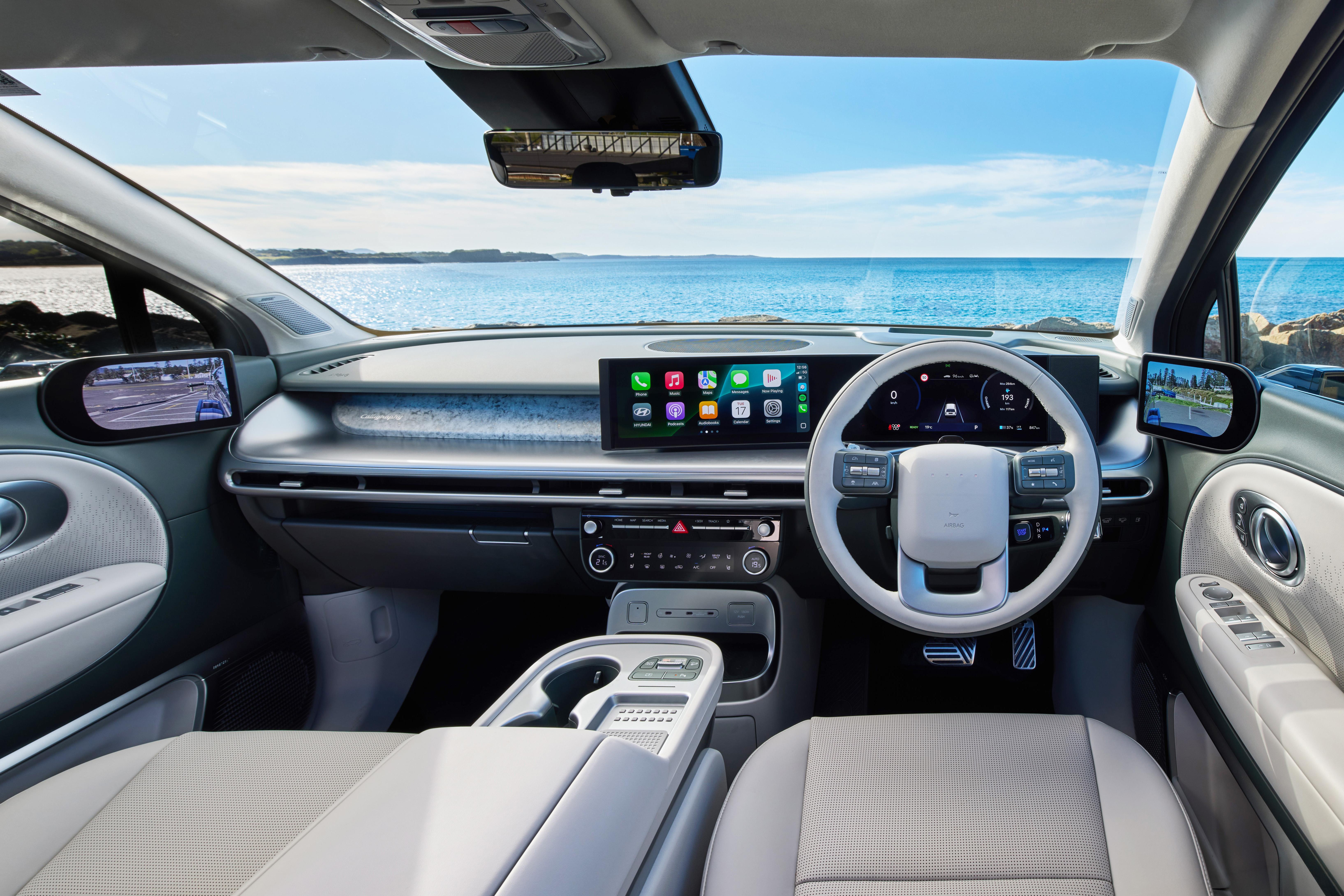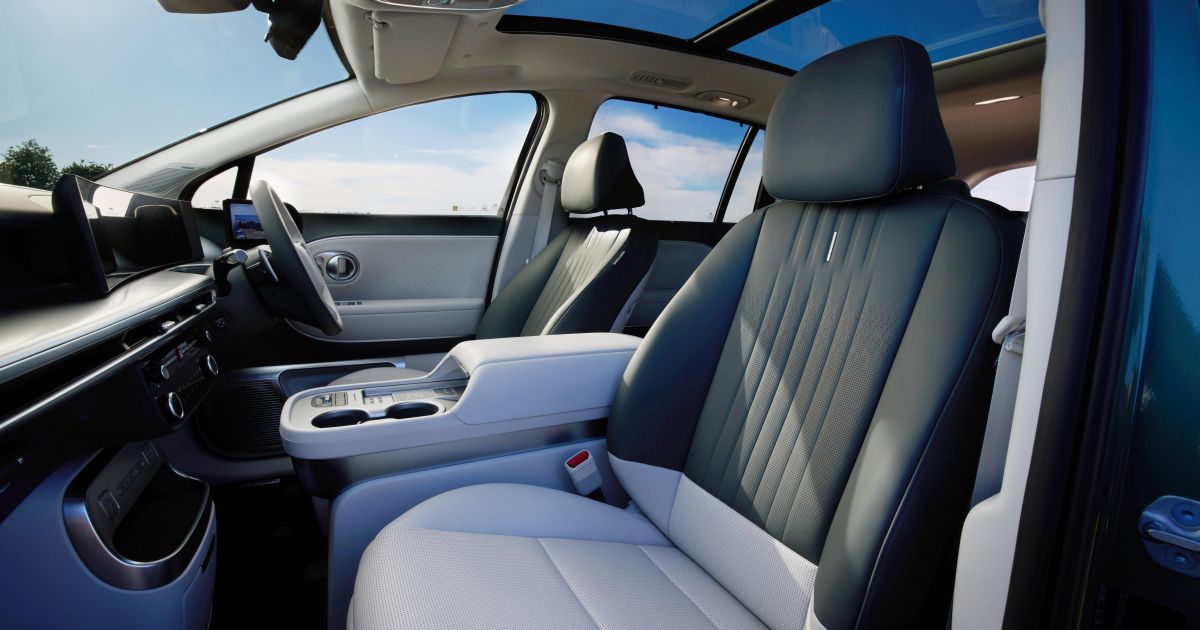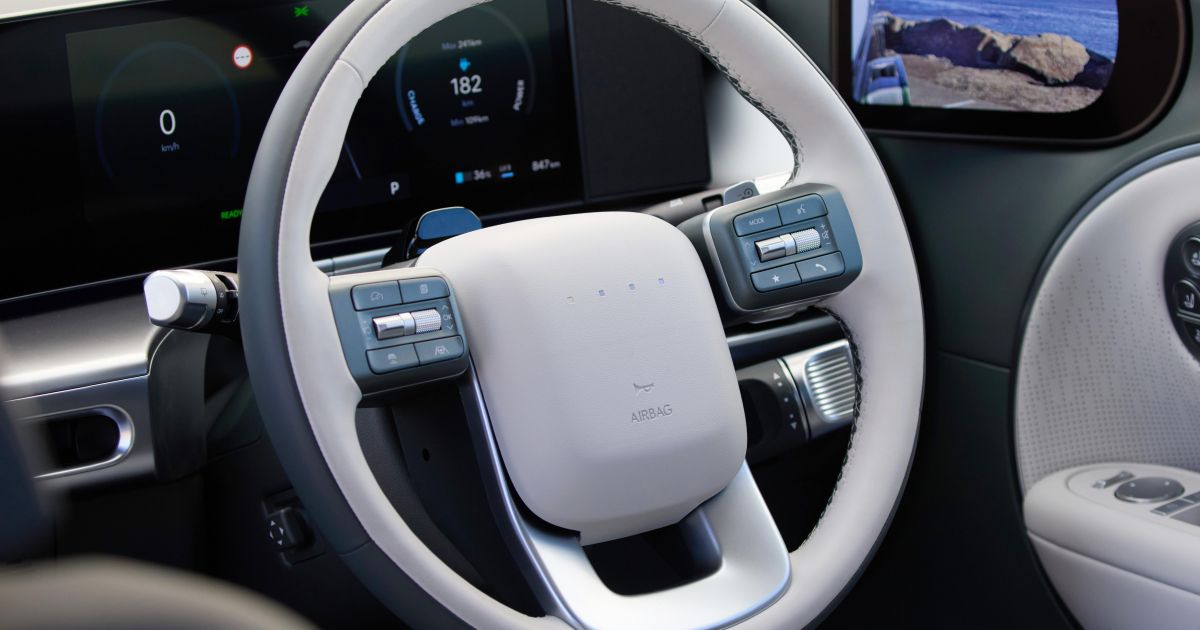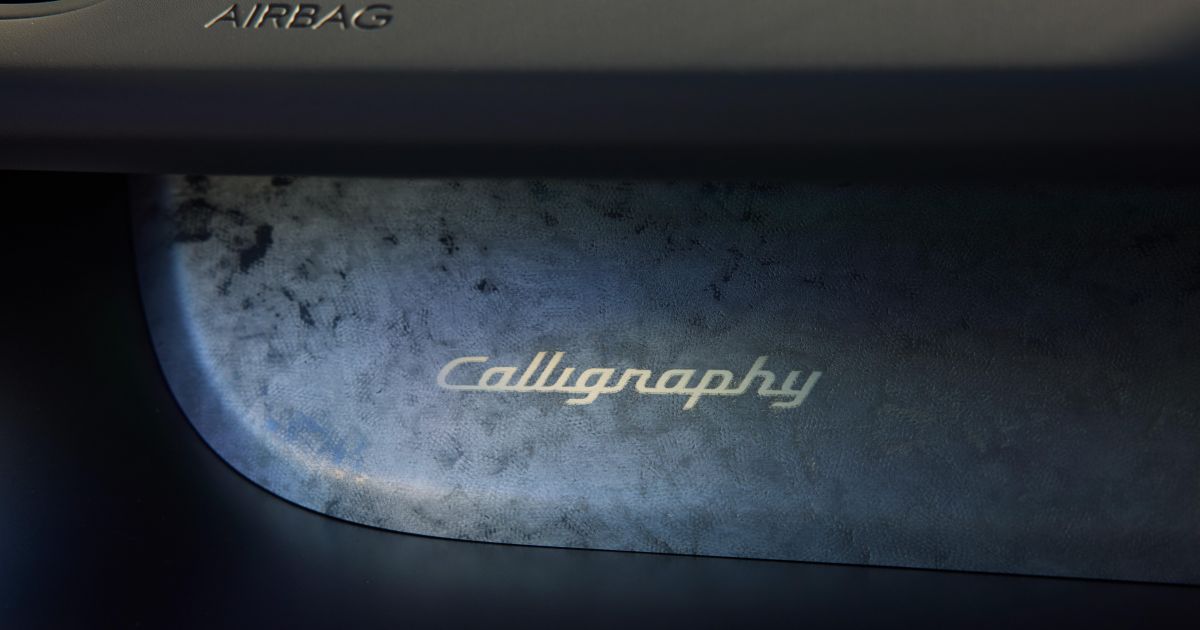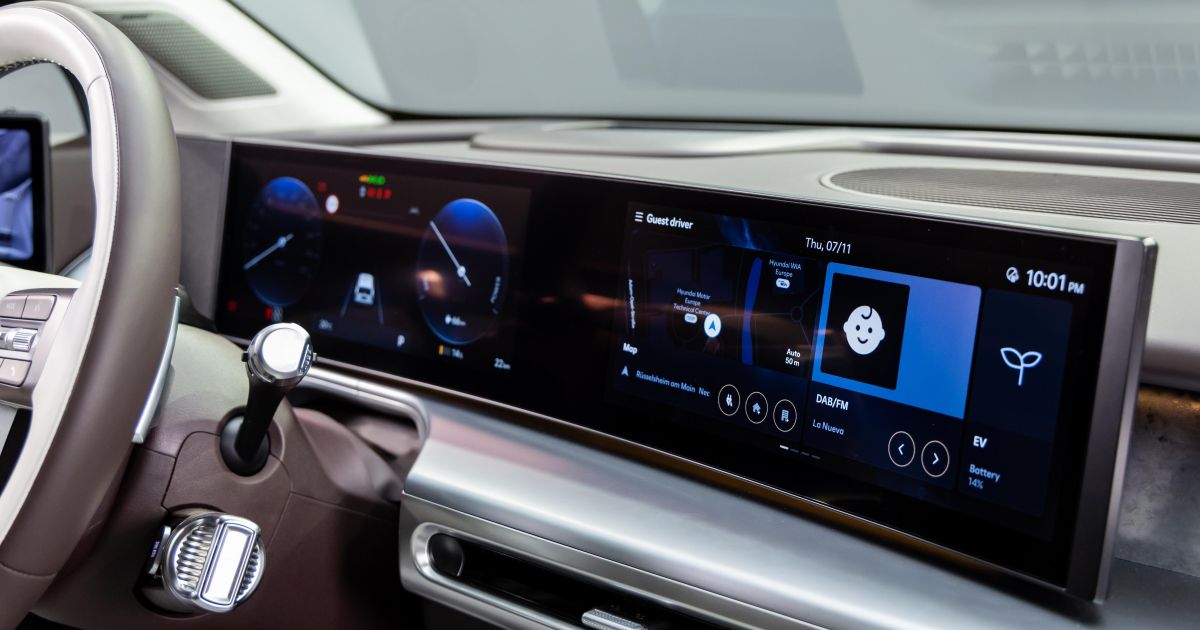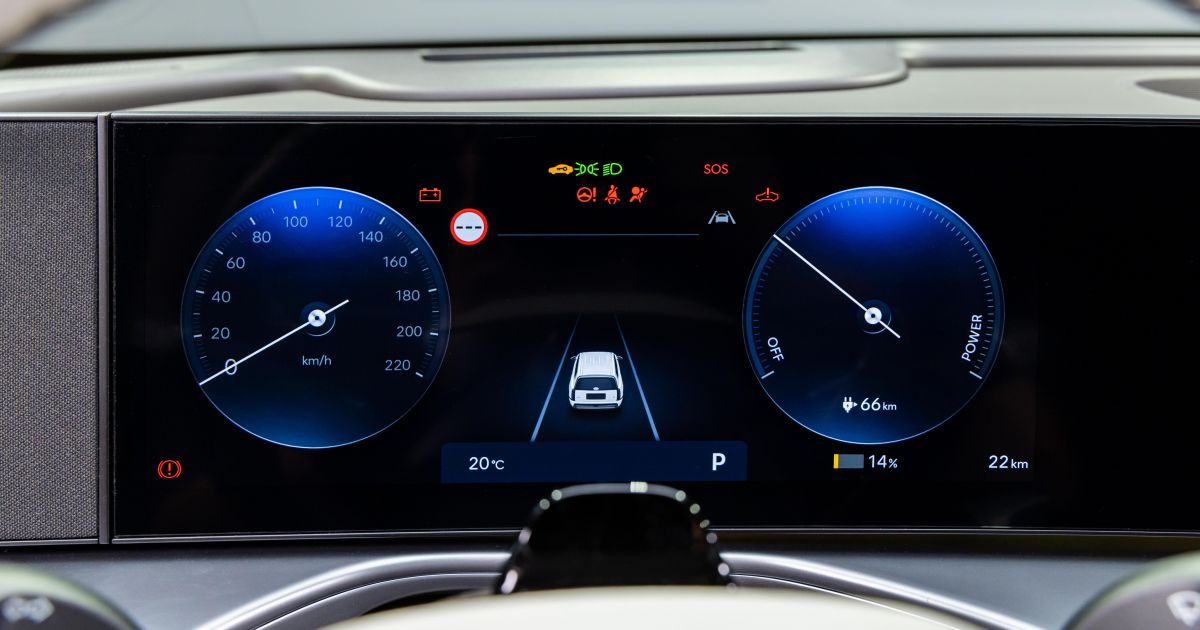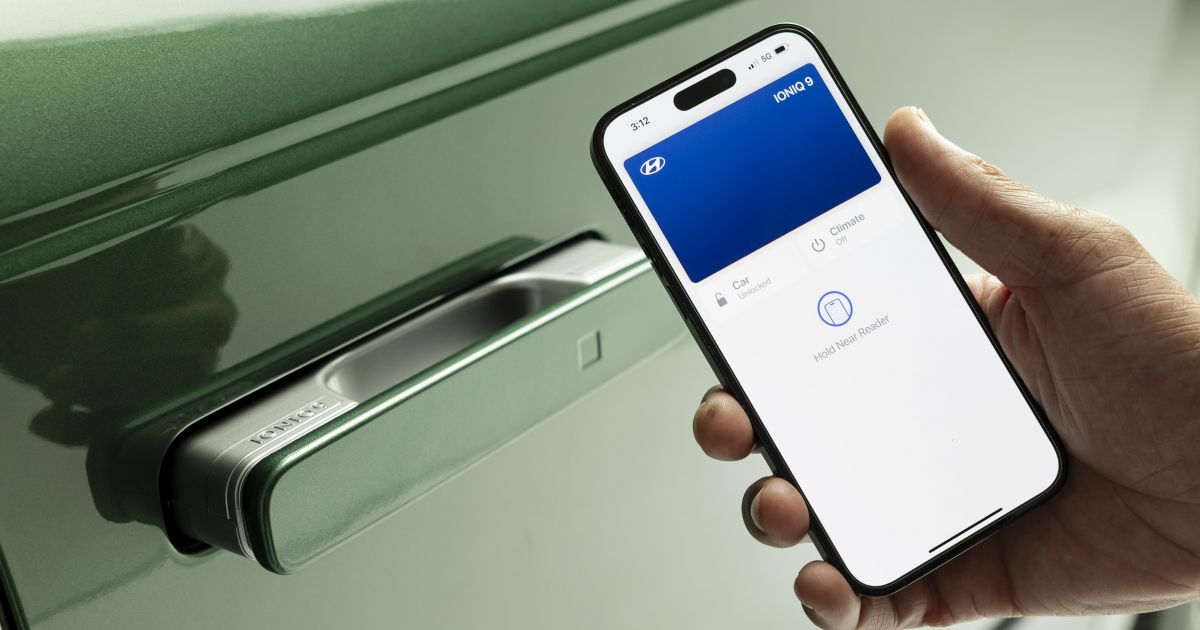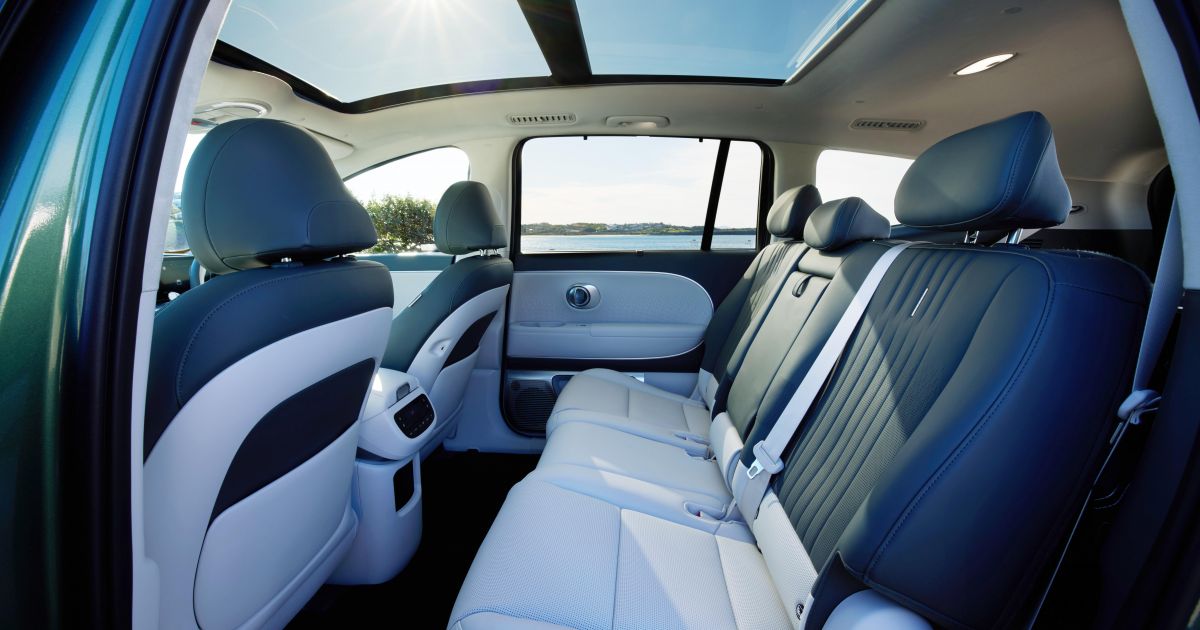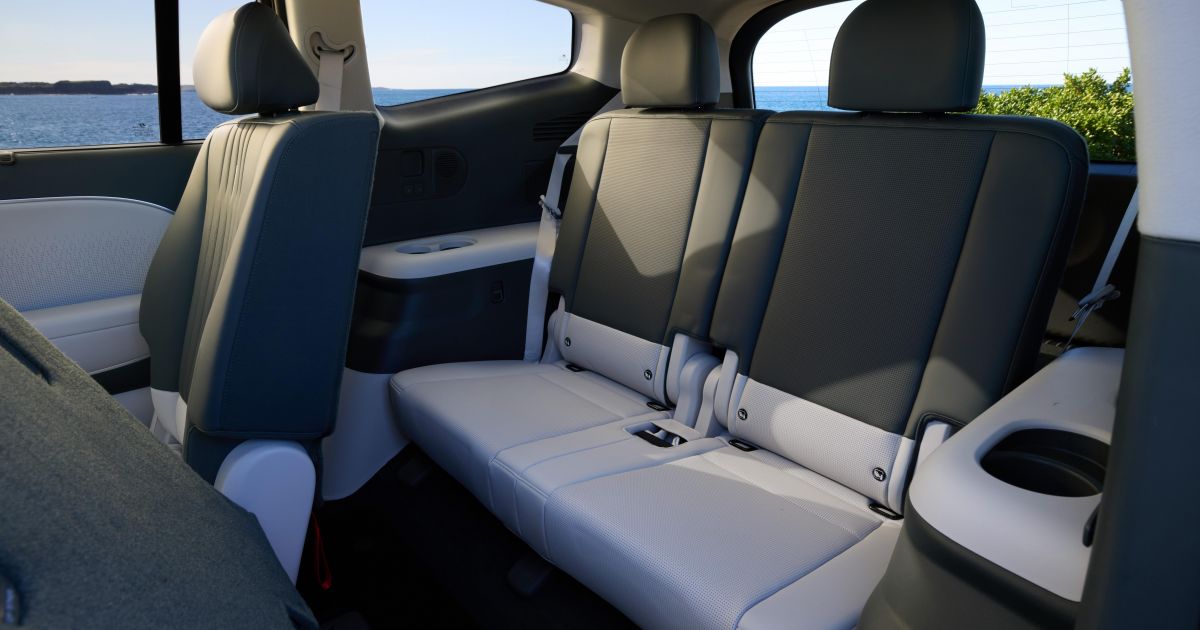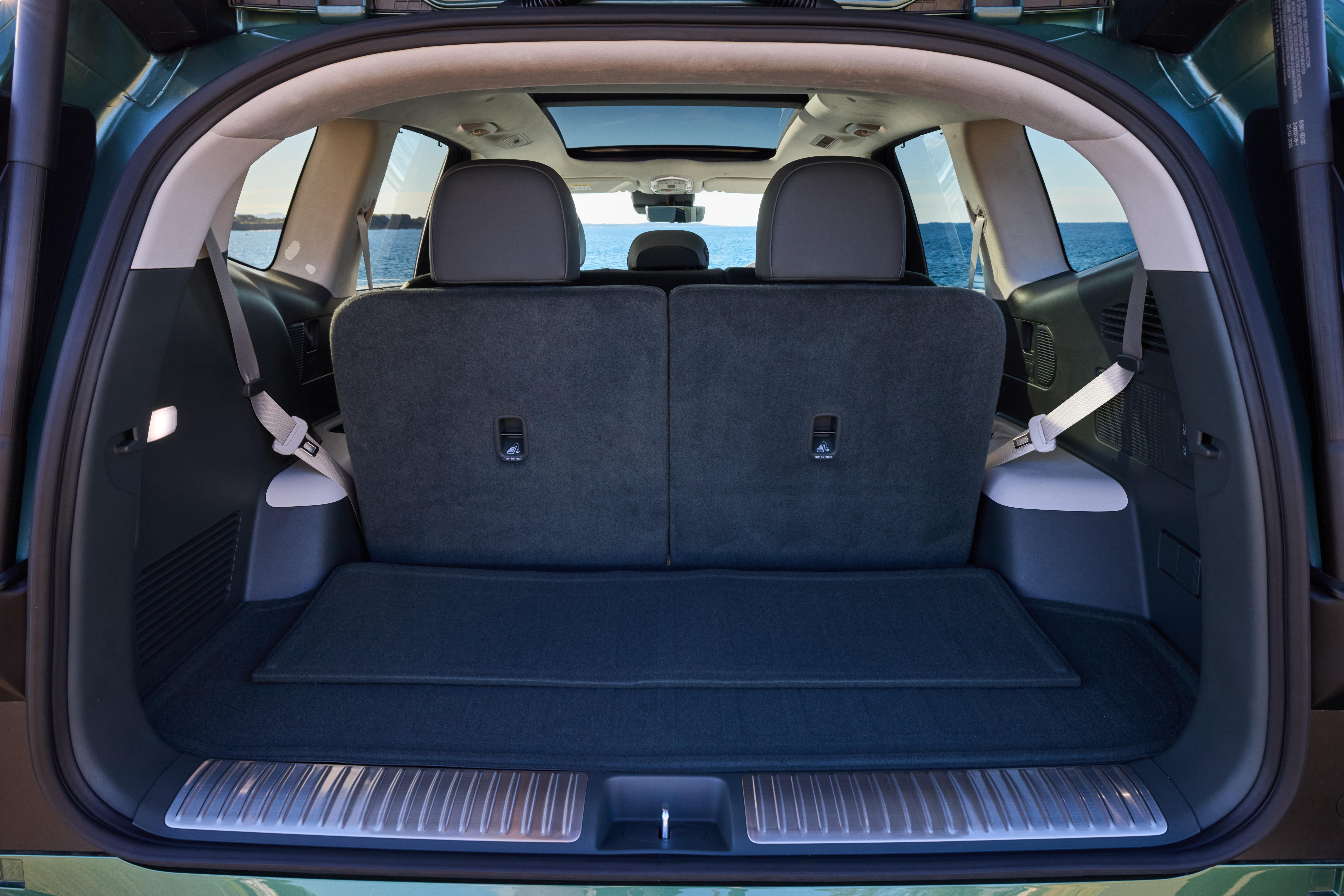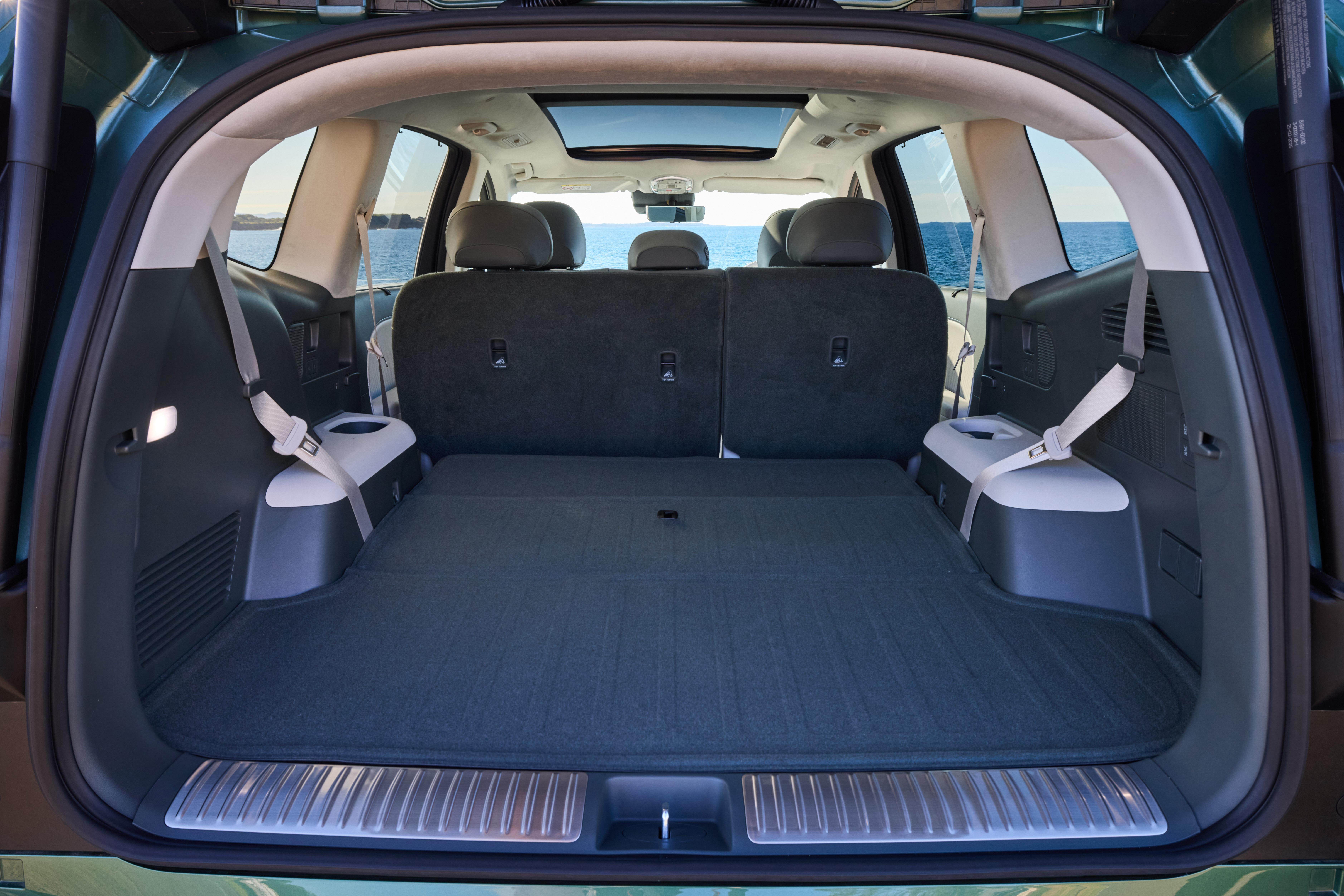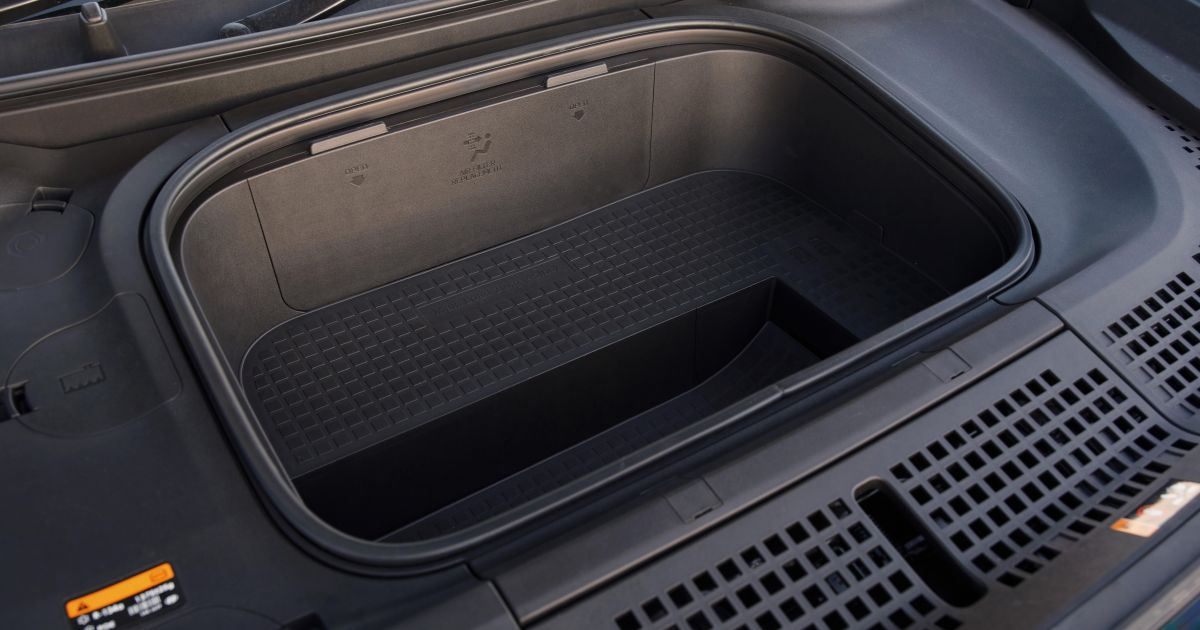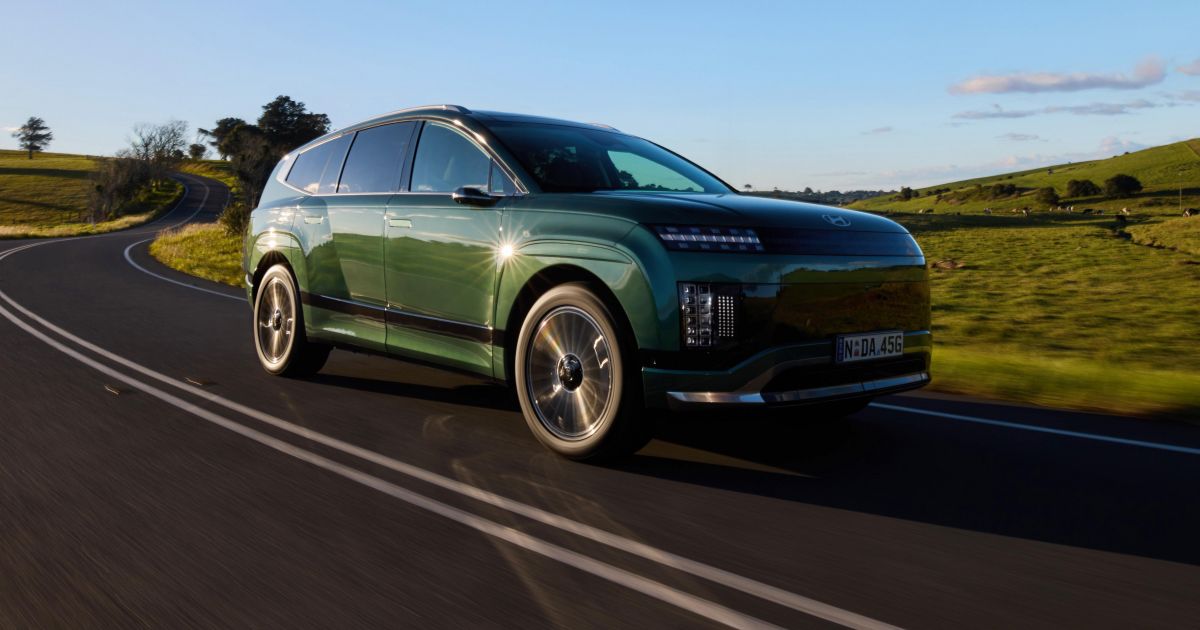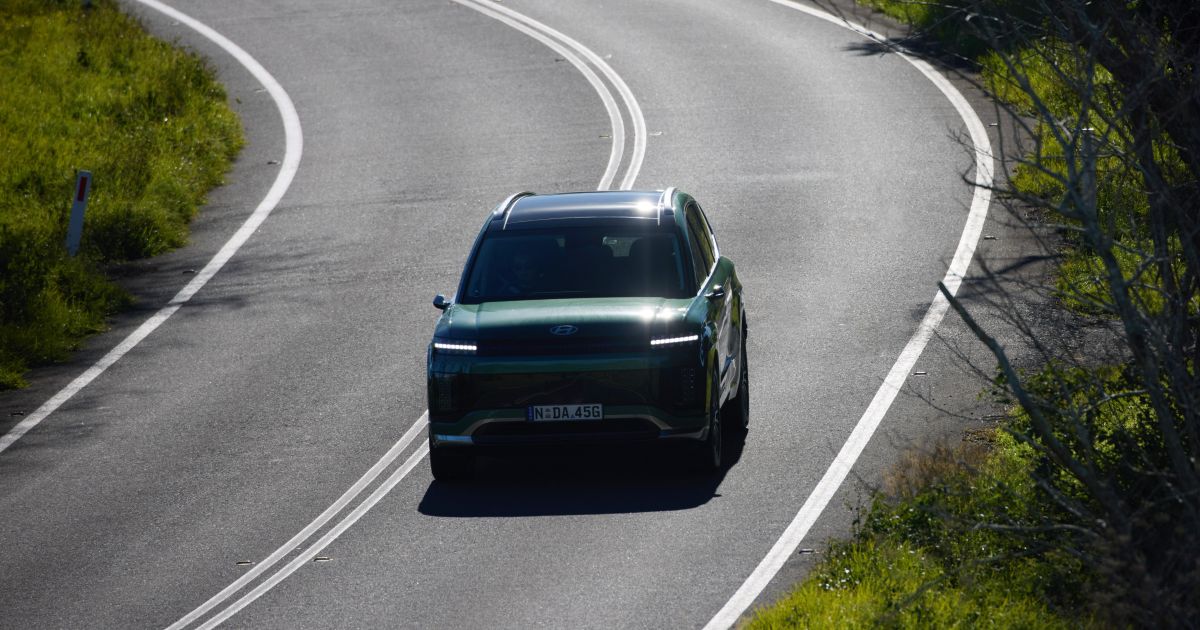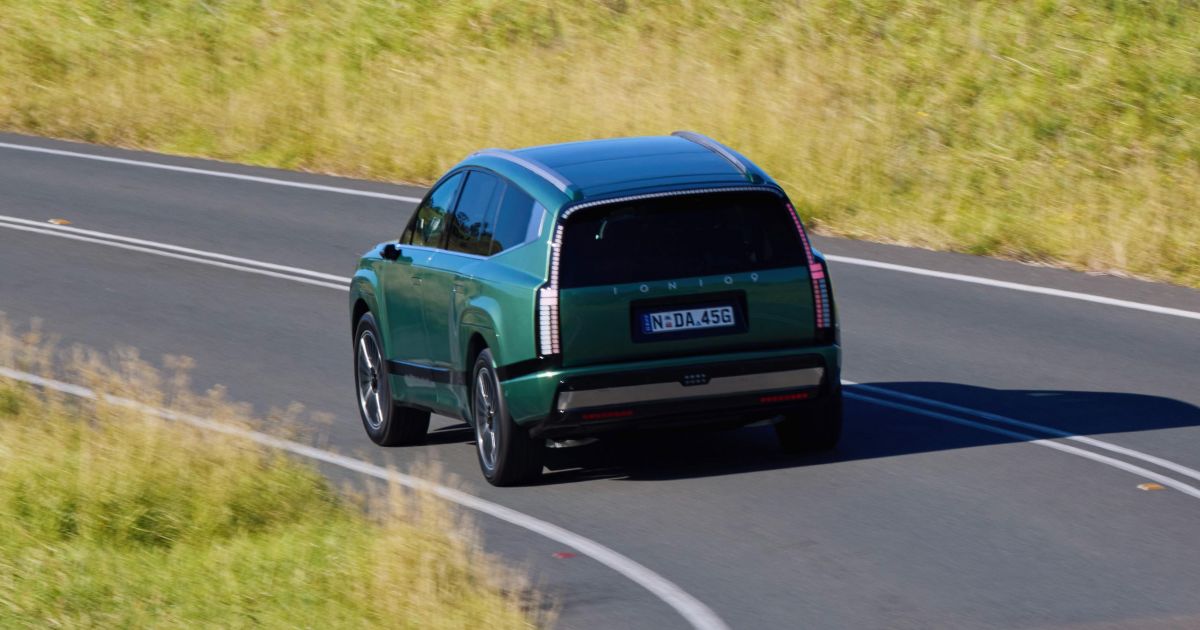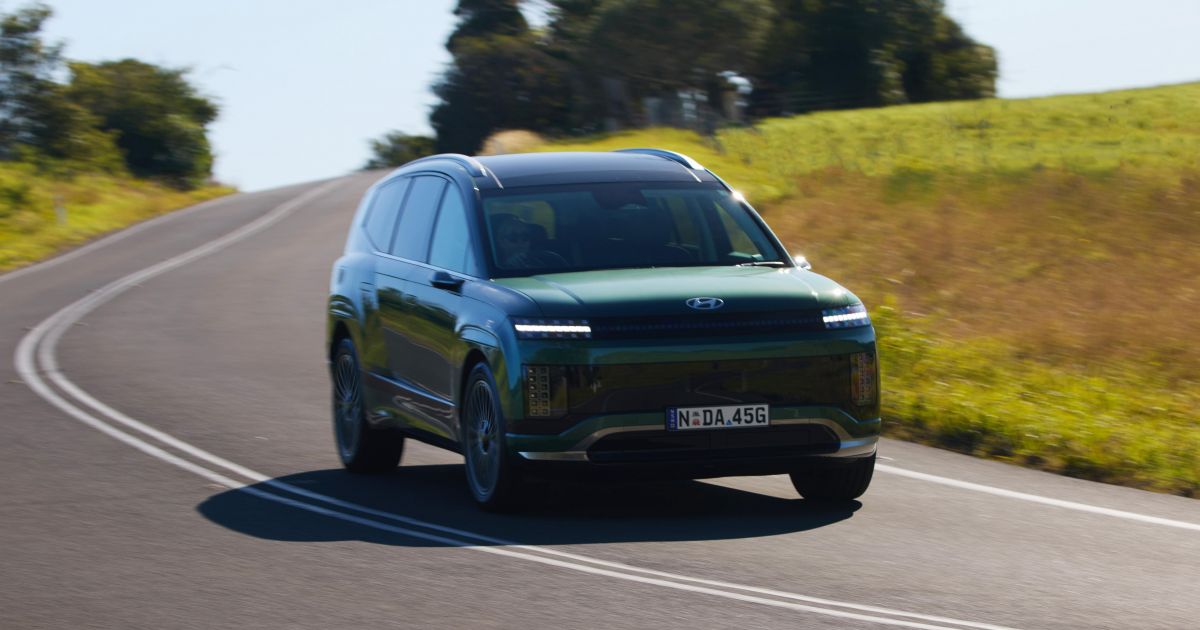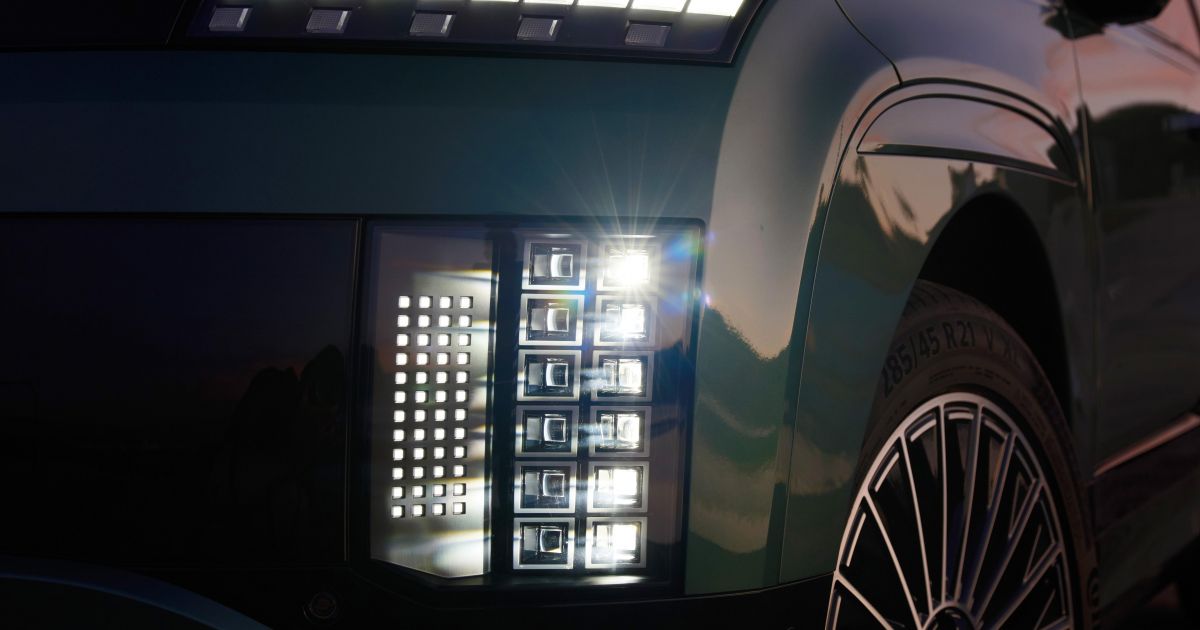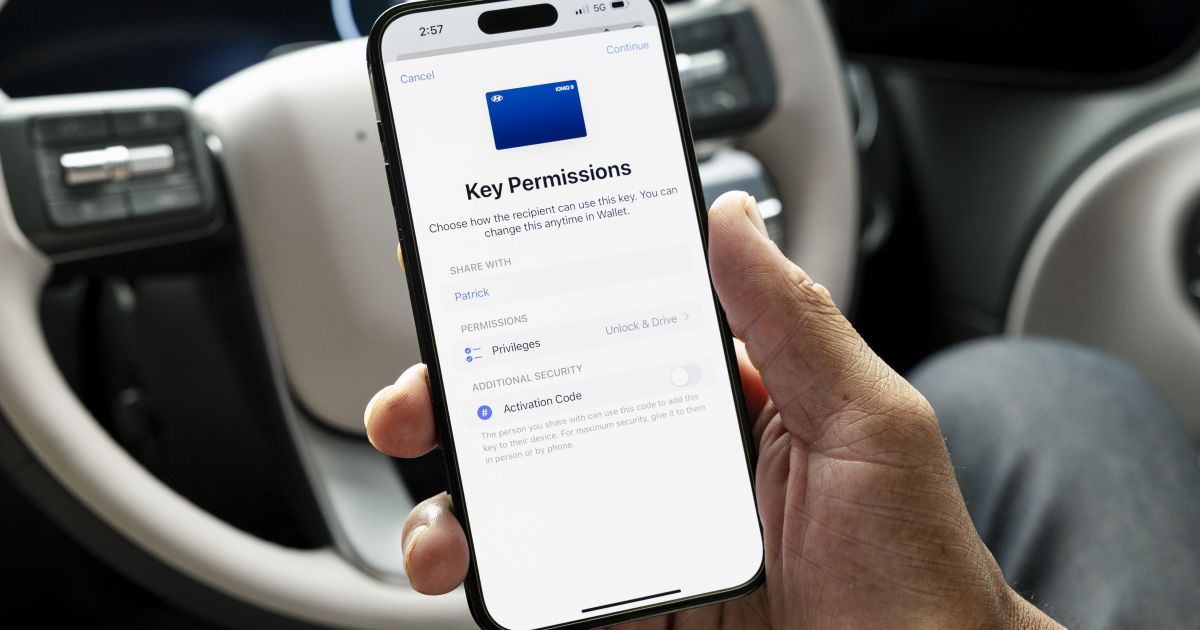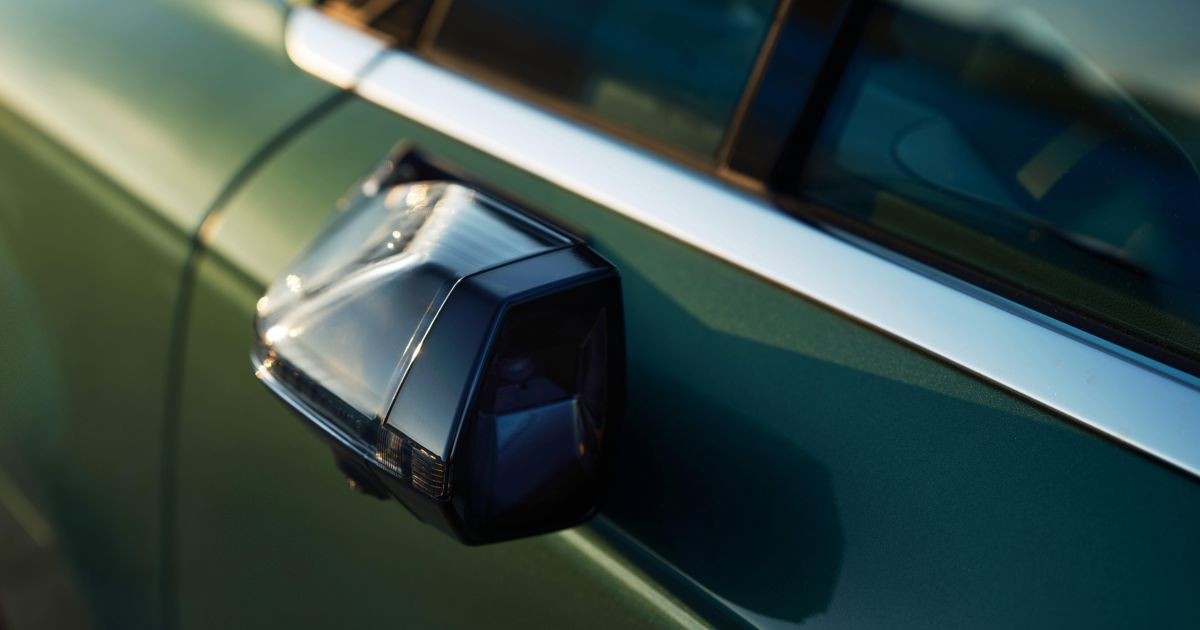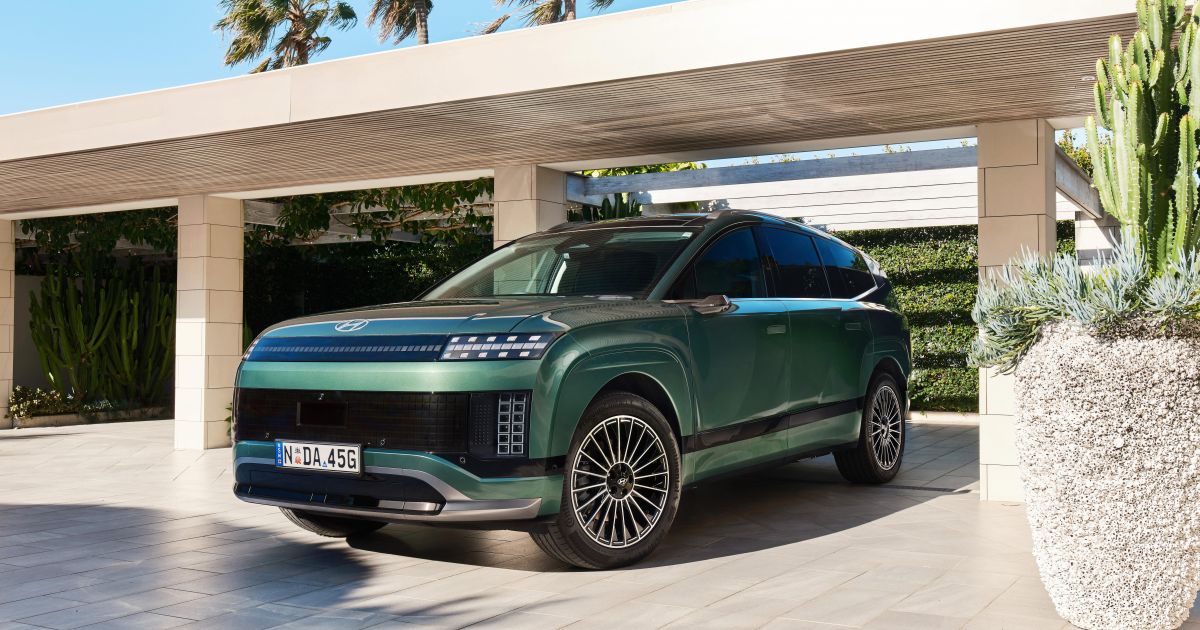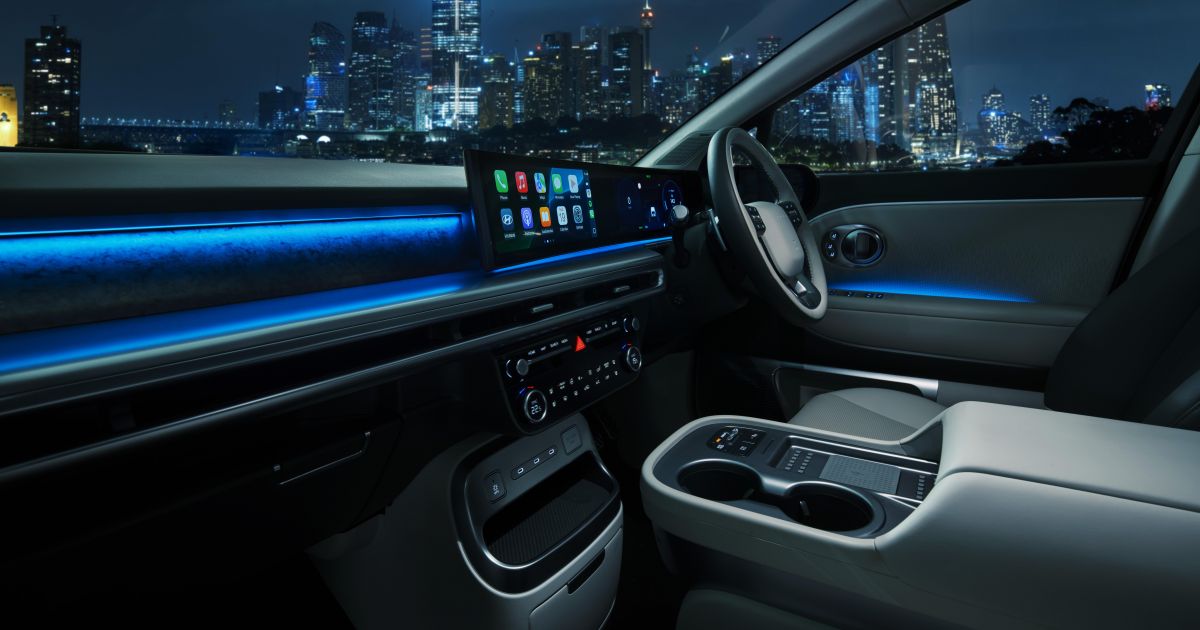First, Hyundai went small with the teeny weeny Inster. Now, they’ve gone big… like really big.
The Ioniq 9 is the most expensive vehicle Hyundai has ever sold in Australia, and you get plenty of metal for your money.
But, to be frank, who even asked for something like the Ioniq 9?
The market for electric vehicles (EVs) remains small in Australia. The market for large electric SUVs? Smaller again. Throw in a hefty $120k price tag… well, you get the picture.
Unsurprisingly, direct rivals for the Ioniq 9 are few and far between. Of course, there’s the Kia EV9, which shares a platform with the car on test here. Outside the Hyundai Motor Group, you’re looking at the Volvo EX90 or dearer German alternatives.
Such a small talent pool should help the Ioniq 9 to draw some attention, but the aforementioned asking price will equally push people away. No matter how far Hyundai has come over the last two decades, many mature motorists will still associate the brand with yesteryear’s Excel, Accent, and Tiburon – hardly premium offerings.
As such, convincing new car buyers to pay six figures for a Hyundai is likely to be a tall order. It’s a task that’ll either be made easier or much more difficult by the quality of the product.
So, is the Ioniq 9 any good? Is it a fitting flagship for Hyundai in Australia? And should you buy one? Read on to find out.
How much does the Hyundai Ioniq 9 cost?
The Ioniq 9 is the priciest Hyundai yet, surpassing even the Ioniq 5 N high-performance electric SUV, which is currently priced at $110,383 before on-road costs.
| Model | Price before on-road costs |
|---|---|
| 2025 Hyundai Ioniq 9 Calligraphy AWD | $119,750 |
The Ioniq 9 rides Hyundai Motor Group’s E-GMP platform, a dedicated architecture for electric vehicles (EVs). This also underpins the similarly sized Kia EV9, which is the Ioniq 9’s most direct rival.
The EV9 is available in three variants, though the flagship GT-Line – most comparable to the Ioniq 9 – is priced at $121,000 before on-road costs.
To see how the Ioniq 9 lines up against the competition, check out our comparison tool
What is the Hyundai Ioniq 9 like on the inside?
The inside of the Ioniq 9 is a step above any Hyundai that has come before it in terms of space, seating comfort, and quality of materials.
Not only is the Ioniq 9 properly large at over five metres long, but it has a lengthy 3130mm wheelbase to match, which means there’s enough room for six or seven to co-exist in comfort.
It really is an SUV-cum-people mover, especially in the six-seat configuration. Removing the middle seat in the second row creates a central walkway that mimics the layout of a proper minivan, while also bringing second-row captain’s chairs that dial up the luxury.
That’s the version to have, even if it means excluding someone from the school carpool.
Whether you’re seated up front or in the ‘premium relaxation’ seats directly behind, this Ioniq 9 has European rivals beat when it comes to comfort.
The front-row chairs are trimmed in perforated Nappa leather and fully kitted out with heating, ventilation, ergo-motion massage functions, and electric adjustment including lumbar. But wait, there’s more – both seats tilt from the base, allowing the passenger to experience a zero-gravity style reclined position. Oh, and don’t forget the extensions that fold out from the front of each seat.
It’s the kind of setup that you’d expect in a Rolls-Royce, not a Hyundai. If I was forced to nitpick, the front pews are a little narrow as a result of sculpted ribcage bolstering – perfect for my build, but broader types might find them to be a tight fit.
Beyond the seats, other elements of the cabin are also geared towards a soft, cushy experience. The two-tone leather steering wheel is heated, and the rest of the front row is trimmed in (mostly) premium materials from top to bottom.
There’s plenty of leather and soft plastics around the place, as well as suede headlining that elevates the space. The marbled dash panel and aluminium surfaces, on the other hand, look and feel a bit naff.
While the Ioniq 9 serves as Hyundai’s flagship, the interior layout and technology aren’t futuristic beyond the point of comprehension.
A pair of 12.3-inch screens sit atop the dash – a central infotainment system and digital driver display – as is customary for modern vehicles. While the panoramic housing looks a little tacked on, the displays are bright, sharp and responsive to inputs.
The infotainment screen utilises a tile menu system that’s familiar and easy to navigate, and there’s a separate panel below the screen containing useful shortcut buttons and climate controls. You can configure a pair of favourite buttons to provide even easier access to commonly used functions like Apple CarPlay.
Other features that may take your fancy include a weather app, voice memos, and Bluelink connected services. You can also lock and unlock the Ioniq 9 using a digital key on your smartphone.
Above: Overseas model shown
Before you ask, the digital key still works if your phone runs out of juice. And once inside, charging options are plentiful – a wireless charging pad, three 110-watt USB-C outlets, and a 12V connection, all in the front row.
The digital driver display combines new technology with traditional design. That means it defaults to old school gauges that flank a centre readout – your choice of efficiency, highway assist , power distribution or driving range.
The appearance of the instrument screen also shifts with each drive mode – ‘Eco’, ‘Normal’, and ‘Sport’.
More driving data can be found on the windscreen courtesy of a head-up display that’s simple, yet effective.
Cabin storage is another strength of the Ioniq 9.
The absence of a transmission tunnel opens up heaps of usable space around the centre console, and the glovebox is exceptionally roomy. There’s an additional storage tray above the glovebox, and door bins fit for drink bottles.
The centre console opens from both ends, allowing rear passengers to cram their odds and ends into it without disturbing the driver. Six-seat versions of the Ioniq 9 have a sliding centre console for extra practicality.
Rear practicality differs depending on the seating configuration, but I maintain that the six-seater is the Ioniq 9 to have. It replaces a standard bench setup with a pair of plush independent recliners that offer both heating and ventilation, as well as a fold-out leg rest – very fancy.
Above: Seven-seat variant shown
The ‘premium relaxation’ seats are also on electric sliders, so even the tallest passengers can access the extra legroom they need. Even in the default setting, I was able to fit behind my driving position just fine.
Headroom is equally plentiful, regardless of seat position. Natural light pours in through a panoramic sunroof, and the windows are substantial.
Thoughtful touches include a hidden storage compartment at the base of the centre console, manual window shades, door-mounted cupholders, and USB-C outlets built into the front seat backs. All chairs are child seat friendly, too.
The third row isn’t quite as well-appointed, but it’s still better than most rivals. It’s easy to get back there using Hyundai’s one-touch walk-in feature, and once seated there are more amenities than one might expect – power-reclining seats for one, as well as USB-C outlets and cupholders on both sides.
The six-seat layout works best with adults occupying first two rows and kids in the third row, although you’ll get a full complement of adults in the seven-seater at a pinch.
If luggage space takes priority over passenger capacity, both rear rows of seating fold almost flat, and the process is easy – simply press a couple buttons attached to the boot wall to drop the benches without using any elbow grease.
Boot space tallies 338 litres with all three rows of seating in use – enough for two small suitcases or a handful of duffel bags – expanding to 908 litres with two rows in place.
A powered tailgate is among the standard equipment, and the boot loading area is flat with no annoying lip. An extra cubby exists under the false floor, which is perfect for stashing away the cargo blind. You’ll also find a tyre repair kit in the absence of a proper spare.
| Dimensions | Hyundai Ioniq 9 |
|---|---|
| Length | 5060mm |
| Width | 1980mm |
| Height | 1790mm |
| Wheelbase | 3130mm |
| Cargo capacity | 338L (behind third row), 908L (third row folded) |
To see how the Ioniq 9 lines up against the competition, check out our comparison tool
What’s under the bonnet?
Nothing, at least in the traditional sense. The Ioniq 9 is being offered here only in dual-motor all-wheel drive guise, with a pair of 157kW/350Nm electric motors.
| Specifications | Hyundai Ioniq 9 |
|---|---|
| Drivetrain | Dual-motor electric |
| Battery | 110.3kWh Nickel-Manganese-Cobalt (NMC) |
| Power | 314kW |
| Torque | 700Nm |
| Drive type | All-wheel drive |
| Weight | 2610-2744kg |
| 0-100km/h (claimed) | 5.2 seconds |
| Energy consumption (estimated) | 19.4kWh/100km |
| Energy consumption (as tested) | 21.2kWh/100km |
| Claimed range | 600km (WLTP) |
| Max AC charge rate | 10.5kW |
| Max DC charge rate | 233kW |
It rides on MacPherson strut front and five-link rear suspension, with a self-levelling damper system to help reduce sag when loaded with heavy cargo.
Hyundai claims it takes as little as 24 minutes to charge the Ioniq 9 from 10 to 80 per cent using a 350kW DC fast-charger.
To see how the Ioniq 9 lines up against the competition, check out our comparison tool
How does the Hyundai Ioniq 9 drive?
Electric power perfectly lends itself to luxurious motoring, and the Ioniq 9’s dual-motor setup serves as proof of that.
As you’d expect, the motors are almost silent, only producing a faint whir under load. Premium, indeed.
The effortless way in which the Ioniq 9 builds speed also enhances its high-end appeal – with 314kW of power and 700Nm of torque at its disposal, this big barge will hit 100km/h from a standstill in just 5.3 seconds. That’s mighty quick for a seven-seat family SUV, and the power is delivered in a smooth and linear manner.
If you’ve got a heavy right foot and want to keep your passengers comfortable, there’s the option to dull throttle response by selecting the ‘Eco’ drive mode.
Slowing down is a similarly smooth experience courtesy of a multi-level regenerative braking system that also allows for single-pedal driving.
Whether you’re going, stopping or cruising, the Ioniq 9 remains quiet on the move. Hyundai has gone to great lengths to insulate the cabin from outside noise, and those efforts have been fruitful.
Foam lining inside each tyre effectively dulls road noise, while double-laminated glass stops wind noise in its tracks. The body structure also features liberally layered sound-deadening, and noise-cancelling sound waves are fed into the cabin via tiny speakers in the headlining.
Those elements combine to create a peaceful cabin ambience that’s only broken when the road gets a little bumpy. That’s because the Ioniq 9 doesn’t ride as well as a $120k luxury SUV should, despite the fitment of advanced suspension technologies.
The Ioniq 9 features a MacPherson multi-link front suspension and rear multi-link suspension with vibration-minimising hydro bushings and a self-levelling damper system designed to reduce vehicle sagging with heavy cargo onboard.
It all sounds great in theory, but the Ioniq 9 feels too busy in town, transmitting the impacts of small road imperfections into the cabin. Chunky 21-inch alloy wheels don’t help in that regard, and there’s no option to drop down a size.
However, comfort improves once you pick up some speed. The Ioniq 9 remains stable over undulating tarmac, and delivers more of the float you expect from an executive express without the associated clumsiness.
I just wish the driver had more control over the suspension setup, as some extra configurability would go a long way to improving the experience at lower speeds.
With that said, the Ioniq 9 handles impressively well for what it is – a 2.7-tonne family wagon. All-wheel drive grip contributes to relatively flat cornering, and there’s remarkable little body roll. Add in well-weighted steering and the Ioniq 9 feels suitably sporty and smaller than it really is, even though you take up plenty of road.
Back to the topic of broken peace and configurability, Hyundai’s usual suite of advanced driver assist systems (ADAS) forms part of the Ioniq 9 package, for better or worse. As we’ve come to expect, the overspeed warnings are annoyingly overbearing, although they’re easily muted by holding down the volume control on the steering wheel.
Likewise, the lane-keep assist system is hard to please, especially considering the width of the vehicle. Thankfully, the Ioniq 9 doesn’t yell at you every time you avert your gaze from the road for a split-second, and the semi-autonomous driving system works as intended on the highway.
While the safety tech can be a bit of a pain at times, certain features come in handy for the urban grind. For example, the inclusion of a digital rear-view mirror vastly improves visibility when the back seats are occupied, and parking is made easier by a bevy of exterior cameras that show the car from every angle.
You need these things when driving the Ioniq 9, as it’s an absolute behemoth that can be a bit of a handful in tight confines. Digital side mirrors, on the other hand, are less of a necessity. In saving $3000, I’d be content sacrificing a couple kilometres of range and running the risk of a mirror hit and run.
On the subject of range, Hyundai claims that the Ioniq 9 can travel up to 600km between charging sessions. That’s a decent chunk more than the EX90 (570km) and EV9 GT-Line (505km) – a key consideration for families interested in weekend road trips.
The Ioniq 9 is also among the fastest charging EVs on sale, with a maximum DC fast-charging capacity of 233kW.
We saw energy consumption of 21.2kWh/100km in the real world, which mirrors that of the standard EX90. Sustained use of ‘Eco’ mode would bring that figure down, although the ‘Normal’ and ‘Sport’ modes have more to offer from a driving pleasure standpoint.
The Ioniq 9 also offers snow, mud and sand terrain modes, not that you’d want to venture too far off the beaten track.
To see how the Ioniq 9 lines up against the competition, check out our comparison tool
What do you get?
There’s just one Ioniq 9 trim level offered in Australia – the top-spec Calligraphy.
2025 Hyundai Ioniq 9 equipment highlights:
- 21-inch alloy wheels
- Tyre mobility kit
- Remote Smart Parking Assist
- Heat pump
- LED headlights with Intelligent Front Lighting System
- Automatic high-beam
- Panoramic sunroof
- Hands-free power tailgate
- Digital Key 2
- Proximity entry with push-button start
- Heated, power-folding exterior mirrors
- Rear privacy glass
- 14-speaker Bose sound system
- Wireless phone charging
- 12.3-inch digital instrument cluster
- Head-up display
- 12.3-inch touchscreen infotainment system
- Satellite navigation with Google Places Search integration
- Over-the-air updates
- Nappa leather upholstery
- Premium Relaxation front seats
- 16-way power adjustment
- Heating
- Ventilation
- 4-way lumbar support
- ‘Ergo motion’ driver’s seat
- Memory for driver’s seat, exterior mirrors, steering wheel
- Second-row 60:40 bench
- Heated and ventilated
- Sliding
- Reclining
- Folding
- Push-button folding
- Push-button tilting (right-hand side only)
- Centre armrest with cupholders
- Power-folding, reclining third-row bench
- Power-folding third-row headrests
- Digital rear-view mirror
- Electrochromic rear-view mirror
- Tri-zone climate control
- Suede headliner
- Leather-wrapped steering wheel
- Power tilt and telescopic steering wheel adjustment with memory
Also included is a complimentary five-year subscription to Hyundai Bluelink connected car services. This is transferrable to subsequent owners within the five-year period, and includes features such as:
- Emergency call (SOS) function
- Automatic collision notification
- Voice recognition for location lookup, vehicle controls
- Live traffic, weather information
- Geo-fencing, valet, speed and time alerts
- Remote control of vehicle functions including locks, climate control
- Remote viewing of vehicle status
Digital exterior mirrors are a $3000 option, while a six-seat configuration is available for an extra $2000, replacing the second-row three-seat bench and bringing:
- Second-row ‘premium relaxation’ seats
- Sliding centre console
- Powered third-row walk-in switch
- One-touch folding and unfolding second-row seats (from cargo area)
To see how the Ioniq 9 lines up against the competition, check out our comparison tool
Is the Hyundai Ioniq 9 safe?
The Hyundai Ioniq 9 has yet to be tested by ANCAP or Euro NCAP.
Standard safety equipment includes:
- 10 airbags (including third row coverage)
- Adaptive cruise control
- Navigation-based cruise
- Autonomous emergency braking
- Junction turning/crossing
- Lane-change oncoming and side
- Evasive steering assist
- Blind-spot assist
- Blind Spot View Monitor
- Driver attention warning
- Highway Driving Assist 2 (combines adaptive cruise, lane centring)
- Intelligent speed limit assist
- Lane Following Assist (lane centring)
- Lane-keep assist
- Rear cross-traffic assist
- Safe Exit Assist
- Rear occupant alert (sensor-based)
- Surround-view camera with 3D view
- Front and rear parking sensors
- Tyre pressure monitoring
Digital exterior mirrors are a $3000 option.
To see how the Ioniq 9 lines up against the competition, check out our comparison tool
How much does the Hyundai Ioniq 9 cost to run?
The Hyundai Ioniq 9 is backed by a five-year, unlimited-kilometre vehicle warranty and an eight-year, 160,000km high-voltage battery warranty.
| Servicing and Warranty | Hyundai Ioniq 9 |
|---|---|
| Warranty | 5 years, unlimited kilometres |
| Roadside assistance | 12 months, then service-activated |
| Service intervals | 24 months or 30,000km |
| Capped-price servicing | Lifetime Service Plan |
| Average annual service cost (5 years) | $269 |
| Total capped-price service cost (5 years) | $1345 |
Under Hyundai’s Lifetime Service Plan capped-price servicing scheme, the Ioniq 9 requires a service at 24 months/30,000km which costs $660, and then one at 48 months or 60,000km which costs $685.
To see how the Ioniq 9 lines up against the competition, check out our comparison tool
CarExpert’s Take on the Hyundai Ioniq 9
The Ioniq 9 is the kind of vehicle you get when bean counters get out of the way and an automaker just produces the best car it possibly can.
I say that because the Ioniq 9 is a highly accomplished electric SUV that deserves praise for its ambition and execution. It’s futuristic without being intimidating, extremely functional, and more premium than any Hyundai in history.
But who’s actually going to buy this thing?
The value proposition is questionable, to say the least. Sure, the Ioniq 9 is slightly more affordable than the equivalent EV9 GT-Line and EX90, but it’s nearly $40,000 dearer than a top-of-the-range Palisade. You could also save some dollars by opting for a base petrol or diesel Audi Q7, a nameplate that has runs on the board in the luxury SUV space.
As such, the Ioniq 9 is only likely to appeal to those who are set on an EV for their next six- or seven-seater. For that small subset of buyers, it’s certainly worth shortlisting, not that there are many alternatives.
In that sense, the Ioniq 9 is similar to its baby brother – the Inster. Both are eye-catching niche EVs that perfectly perform their intended purpose, albeit at an inflated price.
So, while the Ioniq 9 is a great car for Hyundai to stick at the front of its showrooms, it’s not necessarily one for customers to put in their driveway. At least not yet.
Keep an eye out for future discounts or cheaper variants, as there’d be plenty to like about a sub-$100,000 Ioniq 9.
CarExpert can save you thousands on a new Hyundai Ioniq 9. Click here to get a great deal
Click the images for the full gallery

